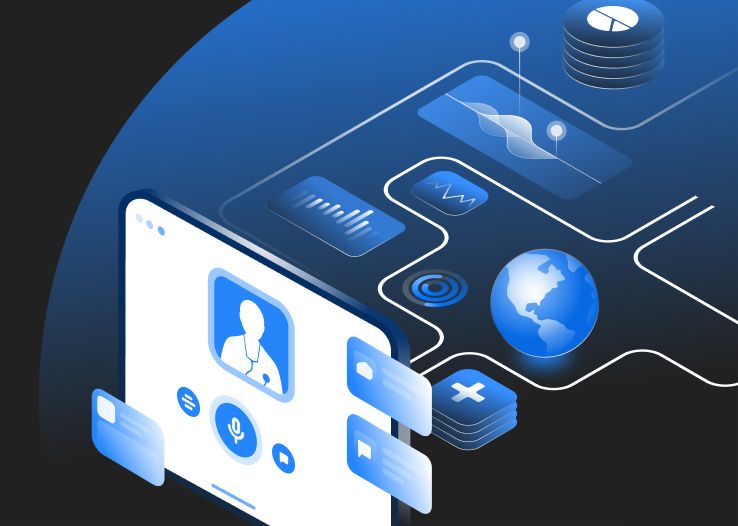Imagine a busy clinic or hospital, where every second counts; legacy systems slow down critical workflows, and doctors struggle to access patient data from siloed sources or have to fill out all the data manually. The attending doctor moves from one patient to another, a simple missing piece of information – latest lab results, modifications to care plans, or an updated prescription – can lead to delays and disrupt the patient's treatment progress. As a result, burnout, patient dissatisfaction, and delays in diagnosis and treatment arise, leaving the C-suite and management constantly addressing accumulating challenges.
This is the reality for many healthcare providers today, where fragmented data and disconnected systems create inefficiencies that not only affect operations but also patient outcomes. In this article, we want to explore key use cases of interoperability in healthcare, where interoperability solutions become a driver for healthcare workflow automation and data integration with a focus on administrative and operational applications in private, specialty, and virtual clinics.
Let’s examine how these solutions streamline healthcare workflows, enhance patient care, and create a more connected and efficient healthcare ecosystem.
Addressing challenges of interoperability in healthcare
One of the primary barriers to interoperability in healthcare has been the fragmentation of patient data across various systems. Outdated systems, proprietary data formats, disparate coding standards, and unclear impact on healthcare business model ROI have long sabotaged data exchange. These challenges have resulted in inefficiencies, increased costs, and potential risks to patient safety due to incomplete or inaccurate information.
To overcome these challenges, organizations are implementing solutions that integrate siloed healthcare data. Let’s see how different solutions leverage technologies to automate patient care, data processing and eventually create more robust, scalable, and secure interoperable systems.
Automated patient intake and registration
Integrating patient registration systems with Electronic Health Records (EHRs) and practice management software has simplified the intake process for hundreds of clinics. For instance, healthcare data integration solutions may help verify insurance eligibility in real-time, pre-populate intake forms with data from previous visits, and automatically assign patients to appropriate care teams.
From the administrative standpoint, automated systems can assign patients to the appropriate care teams based on their clinical history, ensuring that healthcare providers have all relevant information at their fingertips.
The solution architecture may take into account the current IT infrastructure and be built using different models, with each component (e.g., registration, insurance verification, care team assignment) operating independently. This allows for greater flexibility and scalability, as individual services can be updated or scaled without affecting the entire system.
Clinical benefit: Reduces patient wait times, minimizes registration errors, and ensures smoother care transitions, allowing healthcare providers to focus more on patient care rather than administrative tasks.
Intelligent scheduling and resource allocation
Scheduling in clinics is often a complex process, involving multiple variables such as clinician availability, room allocation and equipment readiness. Interoperability enhances scheduling by integrating EHRs and practice management systems, allowing for more precise and efficient resource allocation.
Resources such as surgical suites and imaging equipment are in high demand. Interoperable scheduling systems can monitor the availability of these resources in real-time. A clinic administrator can see which surgeons are available, align their schedules with the availability of operating rooms, and optimize patient flow. The system can also predict the duration of each procedure based on past data, minimizing idle time between patients.
Integrating patient registration with EHRs and practice management systems is key to enhancing the efficiency of patient intake. This way facilities can reduce check-in times and minimize registration errors, ensuring a smoother patient experience and more accurate data handling.
Clinical benefit: Efficient scheduling ensures minimal downtime, better utilization of clinical resources, and reduced patient wait times. Clinicians can spend more time delivering care rather than managing logistics, while patients benefit from more predictable and timely services.
Automated claims processing and revenue cycle management
Efficient claims processing is critical for maintaining financial health in healthcare settings. Integrating clinical and financial systems through automated, interoperable claims processing solutions can reduce claim denials and accelerate reimbursement cycles, ensuring smoother revenue management.
By integrating clinical and financial data through interoperable claims management systems, clinics can automate the entire revenue cycle. This integration can significantly reduce claim denials, improve cash flow, and reduce administrative burdens associated with manual billing.
For instance, a virtual clinic may implement an automated claims processing system that connects directly with its EHR and billing platforms. Once a patient’s procedure is complete, the system automatically generates a bill, reviews it for compliance with insurance policies, and submits it for reimbursement. Any potential issues, such as missing data or mismatches, are flagged for review before submission, reducing the chances of denial.
Clinical benefit: This reduces the administrative burden of manually tracking and submitting claims, freeing up time for staff to focus on patient care. Faster claims processing also means quicker reimbursements and a healthier revenue stream for clinics, ensuring financial stability and operational continuity.

Interoperable inventory management
Effective inventory management in healthcare facilities can prevent stockouts and reduce operational costs. By implementing interoperable inventory management systems that integrate with clinical and operational platforms, clinics can ensure real-time tracking and optimization of inventory levels.
An interoperable inventory solution may automatically track the usage of medical supplies, from gloves to high-value equipment. The system can forecast future needs based on current usage patterns, preventing stockouts or overstocking. If an item is running low, the system can alert administrators to reorder or, in some cases, automatically place the order.
Real-time inventory tracking is achieved through a combination of RFID technology and IoT sensors. These devices communicate with the central system, ensuring low-latency updates even in environments with unreliable network connectivity.
Clinical benefit: Predictive inventory management ensures that clinics always have the necessary supplies, reducing the risk of disruptions in patient care. By preventing stockouts and excess inventory, clinics can also reduce operational costs.
Integrated quality reporting and compliance management
Maintaining high standards in quality reporting and compliance requires deploying systems that can seamlessly integrate data from various sources. Implementing interoperable solutions for quality reporting can streamline compliance processes and improve the accuracy and timeliness of regulatory submissions.
A fully interoperable solution may integrate its clinical systems with a quality reporting platform that automatically tracks compliance with care standards. The system can identify areas where the clinic is falling short of benchmarks and suggest corrective actions, such as improving documentation or updating care protocols.
Clinical benefit: Automated quality reporting ensures clinics meet regulatory requirements without the need for manual audits, freeing up staff time and ensuring better adherence to healthcare standards. Continuous monitoring and reporting also drive improvements in care delivery.

Interoperable telehealth and remote patient monitoring
As telehealth becomes an essential part of the circle of care, ensuring that telehealth platforms integrate with other healthcare systems becomes also a must. Implementing interoperable telehealth solutions can enhance patient engagement, improve chronic disease management, and reduce hospital readmissions.
Ideally, telehealth platforms are built integrated with EHRs and remote monitoring devices and offer real-time health data tracking and patient care. Interoperability allows clinicians to monitor patients with chronic conditions remotely, with automatic alerts for any concerning changes.
Let’s think of a virtual clinic that specializes in managing chronic diseases such as diabetes. Patients use wearable devices that monitor glucose levels in real-time. The data is automatically sent to the clinic’s telehealth platform, which alerts the clinician if any readings fall outside normal parameters. The clinician can then intervene early, adjusting treatment plans without the need for an in-person visit.
Clinical benefit: Remote monitoring reduces hospital readmissions and allows clinicians to provide timely interventions, improving long-term patient outcomes. It also enables patients to manage their conditions more independently, leading to better engagement and adherence to treatment plans.
AI-powered clinical decision support
Leveraging AI in clinical decision-making can significantly improve patient outcomes. Integrating AI-powered decision support systems with EHRs, imaging systems, and other clinical tools ensures that healthcare providers can make more informed, data-driven decisions in real time.
An interoperable decision making solution can be built based on AI models, including deep learning networks for image analysis and natural language processing (NLP) models for extracting insights from both clinical notes and structured data in electronic medical records (EMRs) and electronic health records (EHRs). These AI systems are designed to capture codified conditions, medications, lab results, and other key patient data beyond unstructured clinical notes.
To further support clinical workflows, AI-powered scribing solutions can automate the creation of clinical documentation, allowing clinicians to focus more on patient care. By automatically capturing and organizing patient interactions, including real-time transcription and integration with EHRs, these AI tools reduce the administrative burden. A solution is capable of safely integrating all outputs with other structured clinical data, offering risk assessments and treatment recommendations that span the full spectrum of a patient's medical history.
Clinical benefit: The inclusion of AI-driven insights from structured data like lab results and prescriptions ensures that no critical information is overlooked, ultimately improving diagnostic accuracy, reducing clinical errors, and enhancing patient outcomes through more personalized and timely interventions.
Healthcare interoperability solutions = healthcare 2.0
The integration of interoperable systems in healthcare presents immense opportunities to streamline workflows, enhance patient care, and drive operational efficiencies. By implementing interoperability solutions, clinics and hospitals can break down data silos, enabling seamless data exchange across Electronic Health Records (EHRs), practice management systems, telehealth platforms, and medical devices. Each use case we've explored – from automated patient intake and intelligent scheduling to AI-powered decision support and remote patient monitoring – illustrates how these solutions transform both clinical and administrative workflows.
Interoperability helps healthcare providers respond more effectively to challenges like patient data fragmentation, inefficient scheduling, and claim denials. Automating key processes not only reduces administrative burdens but also empowers clinical teams with real-time insights, ensuring they can deliver more precise, timely, and personalized care. For patients, it means a more connected and responsive healthcare system – one where their data follows them, and their treatment plans are informed by holistic, up-to-date information.
Why Star?
At Star, we've successfully partnered with leading healthcare organizations to build scalable, interoperable solutions that enhance clinical workflows and improve patient outcomes. We collaborated with a top 10 medical equipment manufacturer to design an interoperability platform blueprint that unifies legacy and new devices within medical institutions, enabling seamless cloud and on-premise integration across EHRs, health systems, and MedTech devices. This project not only streamlined device data management but also enhanced clinical efficiency by enabling real-time data analysis and decision-making.
Star partnered with a rapidly growing PBM startup to implement a Surescripts-certified integration that streamlines the prescription process, ensuring patients receive accurate medication information at the point of care. This integration enabled real-time verification of drug coverage, dramatically reducing the time from prescription to patient access while eliminating surprises at the pharmacy. As a result, the client extended coverage to 60,000 pharmacies and achieved a critical milestone, supporting their growth and enhancing patient and provider satisfaction.
In another project, we worked with a major pharmaceutical and MedTech company to refine their interoperability implementation strategy across 25,000 global sites. Through a comprehensive review and workshop-driven approach, we identified key gaps in their deployment processes and developed a scalable strategy that drastically reduced the time needed to implement interoperability solutions at each site, supporting efficient and secure data exchange across their healthcare network.
To explore how interoperability solutions can benefit your organization learn more about our healthcare interoperability services and workshop. Our team of experts can help you identify opportunities for integration and develop a tailored strategy to optimize your clinical and administrative workflows.
By leveraging these healthcare data integration services, providers can position themselves to meet the evolving demands of modern healthcare delivery while improving operational efficiency and patient outcomes. The future of healthcare interoperability lies in the seamless integration of diverse technologies, all working together to create a more connected, efficient, and patient-centered healthcare ecosystem. As we move forward, the organizations that embrace these interoperability solutions will be best positioned to deliver high-quality, cost-effective care in an increasingly complex healthcare landscape.







